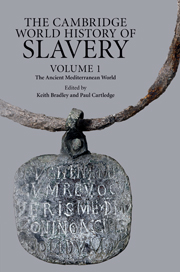Book contents
- Frontmatter
- Contents
- Series editors' introduction
- List of figures
- Acknowledgements
- Introduction
- 1 Slavery in the ancient Near East
- 2 Slaves in Greek literary culture
- 3 Classical Athens
- 4 The Helots: a contemporary review
- 5 Slavery and economy in the Greek world
- 6 The slave supply in classical Greece
- 7 Slavery and the Greek family
- 8 Resistance among chattel slaves in the classical Greek world
- 9 Archaeology and Greek slavery
- 10 Slavery in the Hellenistic world
- 11 Slavery and Roman literary culture
- 12 Slavery in the Roman Republic
- 13 Slavery Under the Principate
- 14 The Roman slave supply
- 15 Slave labour and Roman society
- 16 Slavery and the Roman family
- 17 Resisting slavery at Rome
- 18 Slavery and Roman material culture
- 19 Slavery and Roman law
- 20 Slavery and the Jews
- 21 Slavery and the rise of Christianity
- 22 Slavery in the late Roman world
- Bibliography
- General index
- Index of ancient passages cited
- Index of inscriptions and papyri
- Index of Jewish and Christian Literature Cited
7 - Slavery and the Greek family
Published online by Cambridge University Press: 28 September 2011
- Frontmatter
- Contents
- Series editors' introduction
- List of figures
- Acknowledgements
- Introduction
- 1 Slavery in the ancient Near East
- 2 Slaves in Greek literary culture
- 3 Classical Athens
- 4 The Helots: a contemporary review
- 5 Slavery and economy in the Greek world
- 6 The slave supply in classical Greece
- 7 Slavery and the Greek family
- 8 Resistance among chattel slaves in the classical Greek world
- 9 Archaeology and Greek slavery
- 10 Slavery in the Hellenistic world
- 11 Slavery and Roman literary culture
- 12 Slavery in the Roman Republic
- 13 Slavery Under the Principate
- 14 The Roman slave supply
- 15 Slave labour and Roman society
- 16 Slavery and the Roman family
- 17 Resisting slavery at Rome
- 18 Slavery and Roman material culture
- 19 Slavery and Roman law
- 20 Slavery and the Jews
- 21 Slavery and the rise of Christianity
- 22 Slavery in the late Roman world
- Bibliography
- General index
- Index of ancient passages cited
- Index of inscriptions and papyri
- Index of Jewish and Christian Literature Cited
Summary
INTRODUCTION
By the thirteenth book of Homer's Odyssey, Odysseus has finally reached Ithaca. At first, it seems to be yet another strange island on which he has been cast adrift as an outsider. It takes the last half of the poem for Odysseus to reclaim his identity as the father of Telemachus, Penelope's husband, Ithaca's king. The process begins in the hut of Eumaeus, his swineherd and slave. Odysseus is disguised as an old beggar and does not identify himself even when Eumaeus demonstrates his loyalty to the master who has been gone for so many years. Instead, he weaves a false tale of his origins as the son of a wealthy Cretan and a bought concubine. On equal footing with his legitimate brothers while his father was alive (says Odysseus), he was allotted only a pittance on his death (Od. 14.199–210). Later, Eumaeus reciprocates with his own life story. He was not born a slave but the son of a king. His slave nurse, however, took him with her when she sailed off with a Phoenician seducer. Artemis struck her down on the seventh day at sea, and Odysseus' father Laertes bought the young Eumaeus (15.403–84).
One of these stories is clearly fabricated in Odysseus' crafty fashion, the other (so far as we can tell) no more than the truth.
- Type
- Chapter
- Information
- The Cambridge World History of Slavery , pp. 134 - 152Publisher: Cambridge University PressPrint publication year: 2011
- 4
- Cited by



